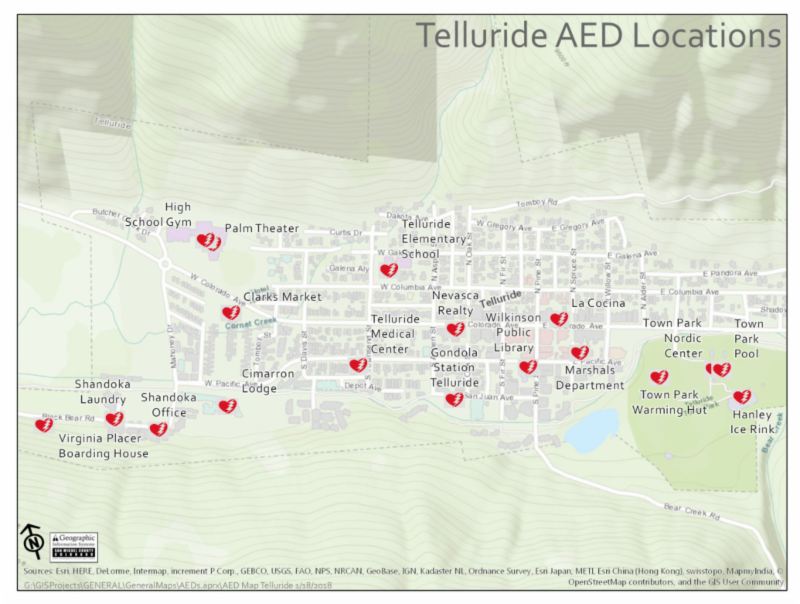
04 Feb Telluride Med Ctr: How Locals & AED Saved A Man’s Life
Last week a group of locals saved someone’s life.

Himay Palmer and Melanie Kent witnessed the man’s collapse on Colorado Avenue, and were the first to run to his aid. Valerie Sloan arrived moments later, and having recently taken a CPR course, quickly recognized his situation warranted an AED (Automated External Defibrillator) and ran to the nearest AED station. Palmer dialed 911; Kent initiated CPR.
Meanwhile, Dr. Bill Hall, an emergency doctor from the Telluride Regional Medical Center’s Emergency Department, and Jill Masters, an experienced paramedic, randomly happened upon the scene.
“A frantic crowd was gathering around a man on the ground, we rushed over.” said Dr. Hall.
Friday’s event was the third time Dr. Hall found himself performing CPR as a citizen.
“It can be difficult to tell if someone’s breathing,” said Dr. Hall. “Especially in winter when people are wearing extra clothing. When in doubt, always err on the side of starting CPR.”
The man was shocked three times with the AED by Masters while Dr. Hall, Kent, Sloan and others rotated CPR compressions.
The fourth shock was delivered by Paramedic Heidi Attenberger just before EMS arrived to the scene. It was then that the patient regained a pulse.
The man went on to receive care at the Telluride Regional Medical Center before being flown to St. Mary’s in Grand Junction, where Dr. Hall has since visited with him.
Background on Telluride’s AEDs
In 2006, Dr. Mark Rosenthal, M.D., a part-time local resident and cardiologist, took it upon himself to establish Telluride as a designated American Heart Association recognized Heart Safe Community.
Dr. Rosenthal collaborated with local government entities and stimulated fundraising to install AEDs throughout the area.
What is an AED and what is it used for?
An AED is a small, portable, electronic device. It can detect life-threatening irregular heart rhythms and then provide an electric shock to reestablish a normal heart rhythm in someone who in cardiac arrest.
When someone goes into cardiac arrest, time is of the essence. In fact, if defibrillation takes place within the first minute, survivability is more than 90%; however, the chance of survival decreases roughly 10% for each minute that passes. Thus, the sooner an AED can be applied, the higher the chance of survival.
What sort of training do I need to use one?
Answer: None.
The genius of AEDs is that a witness to cardiac arrest does not need any training to use one. No one should hesitate to use an AED. Many people with no training whatsoever have saved lives using AEDs. Learn more about how an AED works…
Where are the AEDs in the Telluride area?
It is a good idea to take a minute right now and review the list and map below. At a bare minimum, focus on knowing where the nearest AED is to your house, work, and the places you commonly visit.
AED Locations

Check out all the maps for Telluride, Mountain Village, and elsewhere at tellmed.org or the San Miguel County’s website.
TELLURIDE
Virginia Placer Boarding House; Shandoka Laundry; Shandoka Office; High School: Gym; High School: Palm Lobby; Clark’s Market; Cimarron Lodge; Elementary School: Lobby; Telluride Regional Medical Center; Nevasca Realty; Gondola Station; Wilkinson Public Library; La Cocina; Marshall’s Department; Town Park: Nordic Center; Town Park: Warming Hut; Town Park: Pool; Hanley Ice Rink
The Telluride Regional Medical Center provides the highest quality, comprehensive Primary Care and exceptional Emergency/Trauma Services. Since 1978 – that’s 40 years folks – the institution has evolved, however possible, right along with complex healthcare technologies and population growth – while remaining within the very same 10,000-square-foot remodeled building originally built in the 1960s. Currently the Telluride Hospital District is working to secure a site for a new facility to serve the needs of the region today, tomorrow, and 50 years into the future.


Sorry, the comment form is closed at this time.